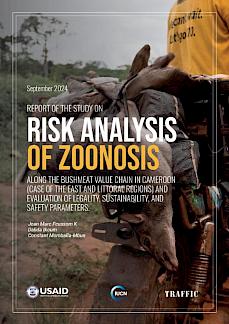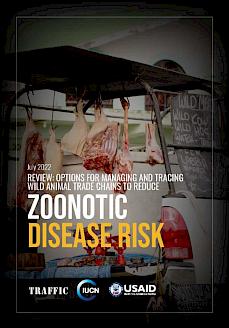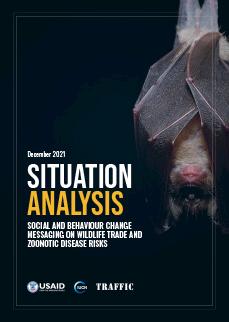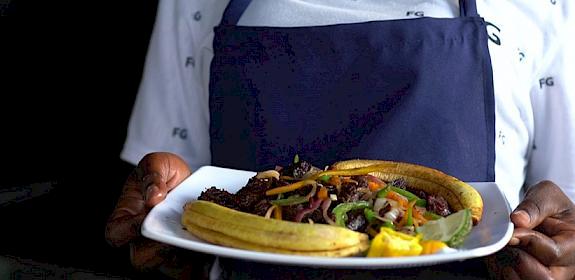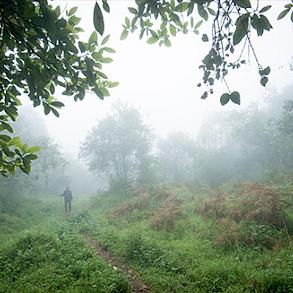
Transmission electron microscope image showing SARS-CoV-2, the virus that causes COVID-19, isolated from a patient in the U.S. Photo: NIAID-RML
i
COVID-19 resource centre
A new coronavirus, designated SARS-CoV-2, is causing a worldwide health pandemic with people infected by a new disease known as COVID-19, which can have fatal consequences.
As of 28th December 2021, more than 5.4 million human fatalities had been reported worldwide with over 280 million confirmed cases of COVID-19.
Aside from COVID-19 being a zoonotic disease whose origins lie in horseshoe bats of the genus Rhinolophus, everything else about SARS-CoV-2's origins is open to question, including the critical question of how it made the species jump from bats to people. By analogy with the SARS virus of 2002/2003 and the MERS virus of 2013, there are suspicions the virus may have made the jump via another animal group, possibly pangolins.
6,718,531 human fatalities
confirmed as of 11th January 2023
While the potential geographic link to a seafood market in Wuhan is far from clear, one thing is certain: the virus has highlighted the very real threat to human health and economic stability caused by zoonotic diseases and the urgent need to mitigate against future outbreaks. The pandemic therefore has profound implications for future wildlife trade policy.
TRAFFIC is actively building partnerships with expertise across the health sectors and with government representatives to help formulate new policies and guidelines to reduce the risk of future pandemics. Those with whom we have been liaising include: the African Union Commission, the Pan African Veterinary Center of the African Union, and the FAO Regional Office for Africa, Germany's Federal Minister of the Environment, Germany's Permanent Representative to the United Nations, the African Development Bank, the Ministry of the Environment of Cote d'Ivoire, the UN Environment Programme, and the South African Minister for Environment, Forestry and Fisheries.
In October 2020, TRAFFIC, alongside the other 13 international organisations in the Collaborative Partnership on Sustainable Wildlife Management (CPW) published a joint statement setting out guiding principles aimed at reducing the risk of future pandemics originating from wild animals while strengthening the conservation of wildlife, and at the same time respecting livelihoods, food security and the culture of diverse groups of people.
Please refer to this Wildlife Trade and Zoonotic Disease Lexicon for definitions of many commonly used terms relating to this topic.
Reports related to COVID-19
Knowledge gaps
Development of appropriate short- and long-term solutions would be strengthened by better insights into the specific origins of the COVID-19 outbreak and into wider questions of zoonosis risk and management strategy.
An initial listing of knowledge gaps follows below and it is hoped that other key areas of enquiry can be identified through dialogue between specialists in relevant fields.
For the COVID-19 outbreak specifically
- What was the pathway of disease outbreak in the human population in terms of animal species involved and locations where transmission occurred?
- Were any disease control measures in place in those places of transmission and, if so, why did they fail?
- Are levels of trade and consumption of wild plant (or animal) species changing as a result of medicinal use for COVID-19 treatment or preventative health care?
On wider risks of zoonoses linked to wildlife trade:
- Are there aspects of wildlife trade for which current measures to prevent transmission of known zoonotic diseases are clearly inadequate?
- Are there particular wildlife species (or species groups) from which transmission of new zoonotic diseases in future is a particular risk?
- What is the effectiveness of predictive modelling for zoonotic disease outbreaks and how might this be improved in future?
- For species considered as presenting significant risk as sources, reservoirs or vectors of new zoonotic diseases, do transmission concerns relate to live animals only or also to particular parts and products?
- What sort of disease prevention measures are most effective along trade routes and in the marketplace?
- How are wildlife consumption patterns changing in light of greater public exposure to the potential related disease risks?
On the potential need to adjust conservation-driven wildlife trade measures:
- What shifts are taking place in flows and routes of wildlife trade and related demand and consumption patterns?
- Is there evidence that prioritisation and design of current responses should be adjusted – e.g. more emphasis on internet-based commerce or on places, species or trade sectors where novel trade and consumption patterns are emerging?
Zoonotic disease risk
The COVID-19 outbreak has highlighted the growing number of examples from recent decades of wildlife- sourced diseases emerging as important human health concerns.
For many of these examples, there are strong indications of disease transmission linked to trade and consumption of wild animal species, including transmission between wild and domestic animals. An environmental epidemiology approach needs to be taken to determine how environmental exposures impact human health, and to understand how various external risk factors may predispose to or protect against disease, illness, injury, developmental abnormalities, or death.
Recommended actions
Conduct a comprehensive risk assessment of zoonotic disease risks from wildlife use and trade with recommendations on remedial changes needed in policy and legislation.
These could include:
- wildlife legislation and regulations needed to monitor and control the ranching, captive breeding, import and export and sale of live animals more effectively, as well as of meat and other products and derivatives for human consumption from wild animals;
- veterinary and animal health legislation and regulations to ensure that the husbandry, production, processing, distribution and introduction of products of wild animal origin do not pose risks to public health;
- consideration of necessary mechanisms to reduce future risk of transmission between domestic agricultural species and wildlife;
- strengthened measures to ensure the traceability or certification of wildlife specimens, including public health considerations that need to be incorporated;
- social behaviour change communications, based upon scientific evidence, needed to prevent consumption of species with potential disease risks.
Impacts summary
Economic Impact
The COVID-19 pandemic has placed many countries in complete economic and social lockdown and is set to usher in a global economic recession of unprecedented scale in modern times. The negative economic impact on the fragile economies of many developing countries will be even more significant. In early April, the World Bank report predicted that Africa's economy could shrink by as much as 5.1% and an African Union report estimates that nearly 20 million jobs on the continent "are threatened with destruction". Rural communities may fall back on wildlife resources in times of economic hardship as a coping strategy and governments may see unfettered exploitation of wildlife, timber and fisheries as one of its strategies to avoid economic catastrophe. Efforts must help communities and governments meet food security and economic needs, while ensuring use of natural resources is sustainable. At the same time, the impact on the private sector wildlife ranching industry is reported to be severe and mitigation measures to identify domestic markets should be considered.
Recommended actions
Conduct a comprehensive assessment of the economic impact of the COVID-19 outbreak on the wildlife economy, including but not limited to the sustainable utilisation of wildlife, with recommendations on strategies needed to strengthen wildlife and rural economies that support poverty reduction and economic growth, particularly of communities affected by the economic impacts of the outbreak.
These could include:
- strengthened measures to ensure the legality and sustainability of wildlife, timber and fisheries harvests and prevent over-exploitation and unsustainable harvesting of these resources;
- guidance for a sustainable wild meat sector within the wildlife economy to develop strategies that reduce the loss of biodiversity, particularly that of wild species used for food, while improving the sustainable use of wild meat for food security and rural livelihoods;
- consider mechanisms to enable local domestic hunting and tourism activities for sustainability of the legitimate regulated wildlife industry.
Livelihoods impact
The impact of the loss of tourism revenue on National, Provincial, community-owned and private protected areas and associated nature-based tourism industry is devastating and resulting in greatly reduced operating budgets to protect, monitor and manage these areas. There are risks of job losses as well as a reduction in opportunities to support local communities living around the parks. In the longer-term, there is a risk that economic recession and changes in people’s behaviour may prevent a full recovery of the tourism, cultural, and recreational activities inside Parks. In parallel, there is understandably likely to be competition for National and International government revenue for health and economic concerns. There is a real need to identify alternative long-term solutions for conservation financing.
Recommended actions
These could include:
- development of poverty reduction and livelihoods strategies and initiatives that encourage community-based wildlife management practices that ensure poverty and livelihoods considerations are integrated into conservation initiatives;
- enact short-term emergency budgeting and funding measures to ensure the ongoing operations of protected and conserved areas;
- development of strategies to explore conservation initiatives that can support and regenerate the nature tourism sector and the communities that depend on it;
- longer-term identification of innovative sustainable financing mechanisms for protected and conserved areas which diversify income sources beyond tourism.
Illegal wildlife trade impacts
It is not yet possible to determine the full impacts of the pandemic on trends in illegal wildlife trade, patterns and dynamics either nationally or internationally. However, illicit trade thrives in periods of economic crisis and this risks the progress that has been made in recent years by countries working hard to address poaching and illegal wildlife trade. It can be expected that organised crime will respond quickly to opportunities being presented by current governmental and societal vulnerabilities and weaknesses. The closure of borders and lockdowns limiting access to customers may limit the ability wildlife criminals to reach physical markets but may also lead to an exponential rise in cybercrime - a phenomenon that has already been seen in many other forms of illicit trade. These restrictions may also lead to significant price increases and stockpiling of many illegal wildlife products.
The pandemic and lockdowns may result in enforcement vulnerabilities that will be exploited by criminals. Trade chains that currently exist, as well as their associated transport systems, have been disrupted but are evolving, and governments will need to identify these changes and respond accordingly.
Recommended actions
Conduct a comprehensive assessment of the impact of the COVID-19 outbreak and its economic repercussions on poaching and illegal trade, with recommendations on strategies needed to strengthen efforts to strengthen law enforcement and address emerging trends and patterns in illicit activity.
These could include:
- identify law enforcement weaknesses and vulnerabilities that will be exploited by criminals as a result of staff illness, furloughs and/or redeployment of resources to COVID-related areas of work and develop action plans to mitigate these;
- monitor any changes to illicit supply chains as a result of the outbreak, as well as their associated transport systems, so as to inform law enforcement action and priorities;
- monitor any impacts on prices, processing of products, stockpiling of illegal wildlife products and other trends and patterns as a result of lockdowns, so as to develop mitigating strategies;
- identify adaptive strategies adopted by wildlife criminals as a result of closure of borders and restricted access to customers, including the use of alternative modes of operation such as the possible increase in the use of the Internet and shipment of small parcels via air transport.
One health
"One Health" is an approach to designing and implementing programmes, policies, legislation and research in which multiple sectors communicate and work together to achieve better public health outcomes across sectors. Efforts by just one sector cannot prevent or eliminate the problem and, a well-coordinated approach in humans and trade in animals is required to contain future outbreaks. Information on viruses circulating in animals is crucial to the selection of viruses for human vaccines for potential spillover pandemics. This approach can only work with the collaboration of many professionals with a range of expertise who are active in different sectors, such as public health, animal health, plant health, wildlife management, economic development, wildlife use and trade, nature conservation, environmental protection and climate change. This approach needs to be adopted at the national, regional and international levels in order to maximise cooperation, synergies and sharing information and best practices.
Recommended actions
- establish a multi-agency and multi-disciplinary national task force to ensure shared objectives, clear roles, effective information sharing and close collaboration in the effective implementation of the above actions, incorporating public health, socio-economic and conservation considerations as part of a one-government approach to addressing the issue;
- develop and / or utilize existing integrated monitoring systems for early detection and response to emerging infectious diseases (EIDs) events, surveillance of EIDs could be linked to existing biodiversity monitoring programs;
- actively develop and promote a holistic national, regional and international response to addressing the current pandemic and mitigating future threats from zoonotic diseases recognising that the challenge cannot be overcome by any single country in isolation.
Get in touch
Contact us for more information on COVID-19, its impact on wildlife trade, and associated guidance and recommendations for global sectors.

